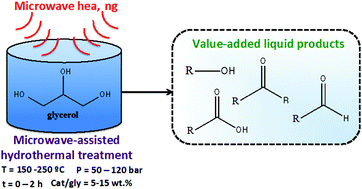Analysis and optimisation of a microwave-assisted hydrothermal process for the production of value-added chemicals from glycerol
Abstract
This work addresses an alternative and green route for glycerol upgrading recently highlighted as a potentially critical aspect of the economic and environmental viability of future biodiesel-based bio-refineries. For the first time we report the microwave-assisted hydrothermal process, examining the effects of the temperature (150–250 °C), pressure (50–120 bar), reaction time (0–2 h) and catalyst mass (5–15 wt%; Ni–Co/Al–Mg) during the upgrading of a 30 wt% glycerol solution. The global glycerol conversion and the carbon converted to gas and liquids varied by 5–54%, 0–21% and 3–42%, respectively. Increasing the temperature, reaction time and/or catalyst amount increased glycerol decomposition due to the positive kinetic effects that these variables have on the process. The pressure exerted two counteracting effects: a positive kinetic effect and a thermodynamic inhibitory influence; this latter being accounted for by the lower dielectric loss factor of water at high pressures. The liquid phase was made up of monohydric (10–62 wt%) and polyhydric (0–46 wt%) alcohols, carboxylic acids (0–9 wt%) and C3-ketones (0–80 wt%). Monohydric alcohols and C3-ketones were the most abundant compounds in the liquid when short reaction times and/or low catalyst amounts were used. An increase in these operating variables increased the concentration of polyhydric alcohols and decreased the amount of C3-ketones. The production of C3-ketones (72 wt%) could be maximised using a medium temperature (210 °C) and low pressure (50 bar) and catalyst mass (5 wt%) for a long reaction time (2 h). Around 40% of the glycerol can be purely converted to monohydric (79 wt%) and polyhydric (21 wt%) alcohols by employing a temperature of 250 °C, a pressure of 83 bar and a catalyst mass of 10 wt% for 2 h.



 Please wait while we load your content...
Please wait while we load your content...